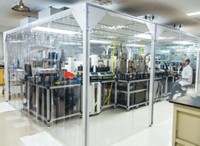Advertisement
Grab your lab coat. Let's get started
Welcome!
Welcome!
Create an account below to get 6 C&EN articles per month, receive newsletters and more - all free.
It seems this is your first time logging in online. Please enter the following information to continue.
As an ACS member you automatically get access to this site. All we need is few more details to create your reading experience.
Not you? Sign in with a different account.
Not you? Sign in with a different account.
ERROR 1
ERROR 1
ERROR 2
ERROR 2
ERROR 2
ERROR 2
ERROR 2
Password and Confirm password must match.
If you have an ACS member number, please enter it here so we can link this account to your membership. (optional)
ERROR 2
ACS values your privacy. By submitting your information, you are gaining access to C&EN and subscribing to our weekly newsletter. We use the information you provide to make your reading experience better, and we will never sell your data to third party members.
Business
Turning The Corner
In the wake of the recession, west coast chemists find jobs in recuperating businesses and emerging fields
by Susan J. Ainsworth
March 21, 2011
| A version of this story appeared in
Volume 89, Issue 12

Over the past few years, the Golden State’s image has become a little tarnished, especially when it comes to its employment situation. At the start of 2011, California’s jobless rate remained at a dizzying 12.5%—the second highest in the U.S., according to the Bureau of Labor Statistics. In addition, Oregon and Washington posted high unemployment rates of 10.6% and 9.3%, respectively, in January.
West Coast chemists have certainly not escaped the turmoil. The Great Recession, which officially ended in June 2009, contributed to job losses that were already mounting as a result of mergers and acquisitions, cutbacks in venture capital funding, and outsourcing of R&D positions to India and China.
Help For The Unemployed
Many chemists are still struggling to find jobs. The American Chemical Society offers special discounts and career assistance to its unemployed members.
National dues: Waiveda
National meeting registration: Free
Regional meeting registration: Reduced fees
ACS Leadership Development System: Reduced rateb
ACS ProSpectives and Short Courses: 50% discount
ACS Member Insurance Program: Life insurance premiums deferred
For a full listing of benefits for unemployed members, visit www.acs.org/unemployed.
Free career-assistance tools for all ACS members:
- Virtual Career Fair
- ACS webinars
- “ACS Careers” blog
- Personal career consulting
- Access to the ACS Network (www.acs.org/ACSnetwork)
For more information, visit www.acs.org/careers.
a Apply for a waiver by contacting ACS with your name and member number via e-mail at service@acs.org or by calling (800) 333-9511 or (614) 447-3776. Dues may be waived for up to two years for unemployed members in good standing. b Enroll in one online course for $25, get three online courses free.
But now, the employment picture for some chemists on the West Coast may finally be brightening. Although growth in job volume for chemists was “flat to declining” last year, it is now “definitely picking up,” according to Alan E. Edwards, a senior director for the Americas Product Group in the scientific arm of Kelly Services, a staffing services company. “I would say that California is climbing back and is now well out of the trough it was in. The West Coast job market for chemists is better than that in the Southeast but still lags behind the Midwest and the Northeast,” he adds.
As companies accelerate hiring, they are doing so cautiously, bringing in more people on a temporary or contingent basis, Edwards says. Eager to stay in step with slow improvements in the economy, companies are hiring in the skills they need for only the period of time that they need them. Changing business models dictate that many professional, highly skilled science positions will now span about 18 to 24 months, he adds.
On the West Coast, hiring seems to be stronger in emerging businesses such as biofuels, solar energy, and biomaterials. And some chemists are finding openings in government labs, which are benefiting from increased funding aimed at energy research and national security, for example.
In addition, the employment situation in the biomedical industry—which includes biopharmaceuticals, medical devices, diagnostics, and academic research—may be less dire than it was a couple of years ago, according to the California Biomedical Industry 2011 Report by the California Healthcare Institute, PricewaterhouseCoopers, and BayBio, a Northern California life sciences trade association. Between March 2009 and March 2010, the industry shed about 1,000 jobs, or only half the number of jobs cut in the same time period a year earlier.
A majority of biomedical industry executives say they plan to increase their workforces in California over the next two years, according to results of the report’s 2011 survey of chief executive officers. During that period, they also anticipate solid growth in R&D and manufacturing in their California operations and slow or flat growth in those same areas for their out-of-state operations.
Although demand for chemists “is improving in certain job categories, demand in others remains depressed,” cautions Meredith Dow, managing partner at San Diego-based staffing consultants firm Proven. “I think it is still really tough out there for medicinal chemists,” Dow says, noting that many of the positions the company has traditionally filled have been outsourced overseas. “Although we used to be able to place medicinal chemists within just a few weeks, we now have some amazing candidates who have been looking for a job for two years.”
Demand, however, is picking up for those with quality-control and analytical chemistry backgrounds, Dow says, adding that many of these candidates are now getting two or three job offers. “Recently, we had a six- to 12-month contract position available for a midlevel analytical chemist, and we could not find anyone to fill it, which was a first,” she says. “A year or two ago, there were numerous available candidates on the market with that background.” Many chemists may have fled the West Coast looking for greener employment pastures on the East Coast, been offered employment locally, or moved into other fields such as regulatory affairs or quality assurance, she conjectures.
Remaining in California, Katherine Schubothe Lancaster has been one beneficiary of the recent increase in demand for analytical chemists. When she was laid off in December 2008 by Dey Pharma, a Napa-based generic drug firm, the Ph.D. analytical chemist found that the job market was “basically nonexistent.”
After taking five months off to stay home with her young daughter, Lancaster started a search for a full-time job in June 2009, but it took until August 2010 for her to find her current position as a senior mass spectrometrist at Bay Bioanalytical Laboratory, a small contract lab in Hercules, Calif. Six months into her search, “jobs started appearing again,” she says, adding that she found her position through the American Society for Mass Spectrometry’s job postings. She loves her new job, which allows her not only to use her biomolecular mass spectrometry experience and quality-control training but also to act as a project manager and work directly with clients, she says.
However, not all chemists have been able to return to jobs like the ones they left. “Many are finding that they must remain open-minded to moving away from the bench and into different fields because the jobs are just not there,” says Mary Canady, founder of San Diego life sciences business development company Comprendia and of the San Diego Biotechnology Network, which now boasts a LinkedIn online networking group of 4,000 members.
Some pharma and biotech chemists are succeeding by moving into business development, “applying what they have learned at the bench to the sales and marketing process,” Kelly Services’ Edwards says. “They are often well qualified to develop strategies for taking products to the market to satisfy the most important customer needs.”
That was true for Jason Moss, a Ph.D. chemist who was laid off in May 2008 from his position as director of research and process development at a San Diego contract manufacturer serving the pharma and biotech industries. A month after his layoff, he took a job as technical manager for business development at Bachem Americas in Torrance, Calif. He now works with sales, marketing, and project management groups on technical issues and provides guidance to clients on peptide and conjugate design and manufacturing strategies.
Although Moss didn’t want to leave the lab and initially “made the move kicking and screaming,” he says he is enjoying his role in business development. “In a purely R&D-focused position, you don’t always get the full picture of the economic and regulatory considerations that justify the science.” Joining the commercial organization at Bachem “has been a great learning experience and helped to broaden my skill set—something that is critical to my career,” he says. “The landscape of R&D and manufacturing is changing faster than ever, so the ability to wear multiple hats and contribute across classical departmental boundaries is key.”

Other chemists have found new positions just outside of the pharma or biotech industries in areas such as medical devices or diagnostics. In November 2010, after an eight-month job search, Ph.D. biochemical engineer Chris Bussineau landed a job as vice president of operations for One Lambda, a Canoga Park, Calif., company that develops and distributes histocompatibility typing tests and manufactures antibody detection products.
Bussineau had been laid off from a position as vice president of pharmaceutical operations at San Diego biotech start-up firm BioVascular in October 2009. He then found himself in the midst of a challenging job market when “most early-stage businesses were struggling with capitalization and larger businesses were shedding employees due to drugs going off patent, failures in the clinic, and consolidation,” he says.
The key to finding his position at One Lambda was his willingness to switch into a new field, he says. The businesses are “different, but related. I’m learning some exciting new technology and embracing the challenge of thinking in much smaller scale than I’ve been trained to do.”
Breaking into the medical device or diagnostics field, however, can be difficult for some chemists with a pharma or biotech background, “who may have to completely retool their skills” to do the work required, recruiter Dow says. “Unless they are able to find a company with a combo product such as a medical device combined with a biologic such as a drug-eluting stent, they may not be able to successfully market their chemistry skills,” she says.
Not surprisingly, many chemists are trying to build on their chemistry foundation and retrain for jobs in fields where workers are in high demand.
To help in that effort, in July 2010 the California Labor & Workforce Development Agency awarded the San Diego region a $4 million grant to implement new workforce training programs for careers in the emerging biofuels industry. The San Diego Biofuels Initiative—a collaborative effort including CleanTECH San Diego, life sciences trade association Biocom, the Biocom Institute, the San Diego Center for Algae Biotechnology, and the San Diego Workforce Partnership—used the grant to set up the Educating & Developing Workers for the Green Economy (EDGE) Initiative.
Beginning this month, the initiative will provide education, training, and placement services to unemployed and dislocated workers including chemists and chemical engineers within the San Diego area, according to Kristie Grover, executive director of the Biocom Institute, which links learning institutions and life sciences companies to build education initiatives.
For those with the requisite skills, jobs seem to be plentiful in the biofuels market. Thanks to his technical expertise in renewable energy and biofuels, Ph.D. inorganic chemist Daniel Derr landed what he considers to be a golden opportunity in October 2010 at Logos Technologies, a small business serving customers across a broad range of technologies and services including biofuels research.
Formerly in the R&D division of a large technology company, Derr now manages a Department of Energy-funded pilot plant project in Visalia, Calif., that is aimed at converting corn-based cellulosic feedstock and other feedstocks to ethanol fuel. “I’m not sure if I can speak for the overall biofuels job market,” Derr notes, “but I can say that Logos and EdeniQ, our partner in this project, are both expanding right now.”
Driven in part by the U.S. government’s increased emphasis on energy research, job opportunities are also growing for chemists within national labs on the West Coast.
More Ph.D. chemists will be needed to support DOE’s push to move away from fossil energy sources toward cleaner sources, according to Bruce C. Garrett, manager of the Chemical & Materials Sciences Division at Pacific Northwest National Laboratory (PNNL), in Richland, Wash.
Some of the 16 chemists who came on board at PNNL last year were hired to support the lab’s new multi-million-dollar Energy Frontier Research Center, which is funded by DOE. Under that program, PNNL’s new Center for Molecular Electrocatalysis will develop potential applications in solar energy and fuel cells.
PNNL, which employs a “much larger percentage of chemists than any other national lab, is also hiring chemists to support national-security-related research,” Garrett says. Physical chemists, with their expertise in spectroscopy and microscopy fields, “are central to detecting biological, chemical, and nuclear threats.”
Because of its work in some of these same research areas, demand for chemists is also growing at Lawrence Livermore National Laboratory, in Livermore, Calif., according to Glenn Fox, leader of its Chemical Sciences Division. Since January 2010, LLNL has hired about 23 chemists within that division alone, and it needs about 15 more right now. “Although the lab started out as a nuclear weapons lab back in 1952,” Fox says, “over the last few years, our programs in energy and national security have grown enormously.”
Growth in hiring at LLNL is also tied in part to the March 2009 completion of construction of the National Ignition Facility (NIF), which is the world’s biggest laser. NIF, a program of DOE’s National Nuclear Security Administration, is aimed at achieving nuclear fusion in the laboratory for applications in national security, carbon-free energy research, and breakthroughs in a variety of scientific disciplines such as materials science, radioactive waste treatment, and medicine.
Advertisement
Regardless of whether they aspire to work in government or in industry, today’s job-seeking chemists must be able to clearly demonstrate how their educational achievements can directly benefit those who are hiring, Kelly Services’ Edwards says. That means candidates must research prospective employers to gain a deep understanding of their technologies and specific goals and objectives before applying to these organizations, he adds.
Having practical experience also helps. Matthew A. Franzman anticipated this need when he sought and landed a postdoc position in the materials science and engineering department at the University of California, Los Angeles, as soon as he graduated with a Ph.D. in chemistry from the University of Southern California in May 2010. “Knowing that I wanted to pursue an industry career in the nanotechnology field, my adviser allowed me to get hands-on experience in device fabrication while I contributed to the department’s nanocrystal synthesis projects,” he says.
His strategy paid off. Five months into his postdoc, Franzman searched the online classifieds website Craigslist and found his current position as a research scientist at Chemat Technology, a Northridge, Calif.-based developer of advanced energy and optical materials. During his interview for the job, Franzman says, Chemat recruiters said that they “were impressed with my synthetic experience and my ability to quickly pick up engineering skills that I was taught during my postdoc.”
But even with a great job in hand, chemists today need to continue to build skills and experience and to stay connected to their networks and community groups, One Lambda’s Bussineau says. Although he worked for one major biotech company for 17 years earlier in his career, his last two jobs each lasted only two years, and both ended “as a result of decisions to downsize to improve the bottom line.”
“I do not think the job market has fully recovered,” Bussineau says. “Some companies are still shedding.” As a result, he adds, it is important to maintain your network “because there is no sure thing out there right now.”





Join the conversation
Contact the reporter
Submit a Letter to the Editor for publication
Engage with us on Twitter